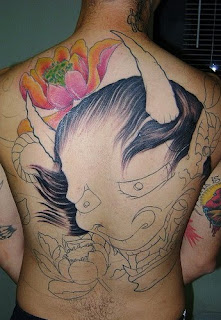
The
hannya mask is just one example of the many different types of masks used by the traditional Japanese actors of Noh theater. Noh performances are very stylized representations of traditional and well known stories, developed in Japan during the 14th century. The masks are used to convey the identity and mood of the various characters, who number nearly eighty in the different tales. The hannya mask is specifically used to represent a vengeful and jealous woman. Her anger and envy have so consumed her that she has turned into a demon, but with some important traces of humanity left. The pointed horns, gleaming eyes, fang-like teeth, combined with a look of pure resentment and hate are tempered by the expression of suffering around the eyes and the artfully disarrayed strands of hair, which indicate passionate emotion thrown into disorder. The deeper and more extreme the coloring of the face, the deeper and more violent run the emotions of the character. Tattooing takes full advantage of these fanciful and engaging images, often using them in larger pieces of Japanese work or sometimes juxtaposing masks of good and evil characters. Often a Noh mask will also appear in isolation, as a work of art unto itself, not unlike the actual masks which are highly prized and very collectible.

Even to this day, in Japan, a hand gesture of two index fingers sticking up from a man’s forehead is an indication that his wife is mad at him or jealous. A more reddish color indicates strong resentment and anger and is used in such plays as Dodoji and Kurozuka, whereas a paler color would be more appropriate for Aoi-no-ue. Dodoji is the story of unrequited love between a woman and a priest of Dodoji (temple). She turns into a demonic serpent who wraps her body around the temple bell consuming it and the priest in the process.
 The hannya mask is just one example of the many different types of masks used by the traditional Japanese actors of Noh theater. Noh performances are very stylized representations of traditional and well known stories, developed in Japan during the 14th century. The masks are used to convey the identity and mood of the various characters, who number nearly eighty in the different tales. The hannya mask is specifically used to represent a vengeful and jealous woman. Her anger and envy have so consumed her that she has turned into a demon, but with some important traces of humanity left. The pointed horns, gleaming eyes, fang-like teeth, combined with a look of pure resentment and hate are tempered by the expression of suffering around the eyes and the artfully disarrayed strands of hair, which indicate passionate emotion thrown into disorder. The deeper and more extreme the coloring of the face, the deeper and more violent run the emotions of the character. Tattooing takes full advantage of these fanciful and engaging images, often using them in larger pieces of Japanese work or sometimes juxtaposing masks of good and evil characters. Often a Noh mask will also appear in isolation, as a work of art unto itself, not unlike the actual masks which are highly prized and very collectible.
The hannya mask is just one example of the many different types of masks used by the traditional Japanese actors of Noh theater. Noh performances are very stylized representations of traditional and well known stories, developed in Japan during the 14th century. The masks are used to convey the identity and mood of the various characters, who number nearly eighty in the different tales. The hannya mask is specifically used to represent a vengeful and jealous woman. Her anger and envy have so consumed her that she has turned into a demon, but with some important traces of humanity left. The pointed horns, gleaming eyes, fang-like teeth, combined with a look of pure resentment and hate are tempered by the expression of suffering around the eyes and the artfully disarrayed strands of hair, which indicate passionate emotion thrown into disorder. The deeper and more extreme the coloring of the face, the deeper and more violent run the emotions of the character. Tattooing takes full advantage of these fanciful and engaging images, often using them in larger pieces of Japanese work or sometimes juxtaposing masks of good and evil characters. Often a Noh mask will also appear in isolation, as a work of art unto itself, not unlike the actual masks which are highly prized and very collectible. Even to this day, in Japan, a hand gesture of two index fingers sticking up from a man’s forehead is an indication that his wife is mad at him or jealous. A more reddish color indicates strong resentment and anger and is used in such plays as Dodoji and Kurozuka, whereas a paler color would be more appropriate for Aoi-no-ue. Dodoji is the story of unrequited love between a woman and a priest of Dodoji (temple). She turns into a demonic serpent who wraps her body around the temple bell consuming it and the priest in the process.
Even to this day, in Japan, a hand gesture of two index fingers sticking up from a man’s forehead is an indication that his wife is mad at him or jealous. A more reddish color indicates strong resentment and anger and is used in such plays as Dodoji and Kurozuka, whereas a paler color would be more appropriate for Aoi-no-ue. Dodoji is the story of unrequited love between a woman and a priest of Dodoji (temple). She turns into a demonic serpent who wraps her body around the temple bell consuming it and the priest in the process.